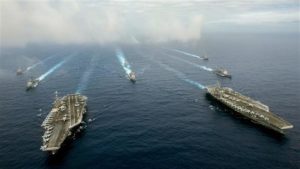by WorldTribune Staff, June 19, 2016
The United States has sent two aircraft carriers to an exercise in the Philippine Sea in a show of force ahead of a key arbitration decision on a South China Sea territorial dispute.
The Nimitz-class supercarriers USS Ronald Reagan and USS John C. Stennis conducted air defense and sea surveillance operations in the Philippine Sea on June 18, U.S. Pacific Command said in a statement.

The maritime exercise included 12,000 sailors, 140 aircraft and six smaller warships.
“The ships and aircraft assigned to both strike groups began coordinated operations in international waters demonstrating the United States’ unique capability to operate multiple carrier strike groups in close proximity,” U.S. Pacific Command said.
“While at sea, the strike groups conducted air defense drills, sea surveillance, replenishments at sea, defensive air combat training, long range strikes, coordinated maneuvers and other exercises.”
The exercise was held ahead of an arbitration tribunal’s expected verdict at the Hague on a territorial dispute between China and the Philippines in the South China Sea. Analysts expect the verdict to favor the Philippines, which filed the case in 2013.
An American official told The New York Times on condition of anonymity that the U.S. exercise coinciding with the expected UN verdict on the South China Sea was “deliberate.”
Beijing, which claims nearly all of the South China Sea, said the Philippine Sea exercise was another move by the U.S. to “contain” China.
Pacific Command said the U.S., as a “Pacific nation and a Pacific leader… has a national interest in maintaining security and prosperity, the peaceful resolution of disputes, unimpeded lawful commerce, and adherence to freedom of navigation and overflight throughout the shared domains of the Indo-Asia Pacific.”
